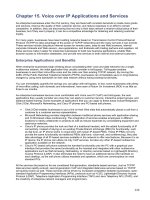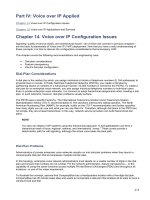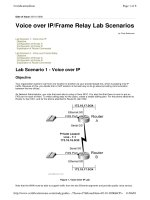Implementing Voice Over IP - Preface
Bạn đang xem bản rút gọn của tài liệu. Xem và tải ngay bản đầy đủ của tài liệu tại đây (40.24 KB, 3 trang )
PREFACE
In general, voice transmission over the Internet protocol (IP), or VoIP, means
transmission of real-time voice signals and associated call control information
over an IP-based (public or private) network. The term IP telephony is com-
monly used to specify delivery of a superset of the advanced public switched
telephone network (PSTN) services using IP phones and IP-based access,
transport, and control networks. These networks can be either logically over-
layed on the public Internet or connected to the Internet via one or more gate-
ways or edge routers with appropriate service protection functions embedded
in them. In this book, I use VoIP and IP telephony synonymously, most of the
times.
This book grew out of my participation in many VoIP-related projects over
the past several years. Some of the early projects were exploratory in nature;
oscillators had to be used to generate certain tones or signals, and oscilloscopes
were used to measure the dial-tone delay, call setup time, and voice transmis-
sion delay. However, as the technology matured, a handful of test and mea-
surement devices became available. Consequently, we turned out to be better
equipped to make more informed decisions regarding the computing and net-
working infrastructures that are required to implement the VoIP service. Many
of the recent VoIP-related projects in the enterprise and public network indus-
tries involve specifying a VoIP service design or upgrading an existing VoIP
service platform to satisfy the growth and/or additional feature requirements of
the customers. These are living proof of the facts that all-distance voice trans-
mission service providers (retailers and wholesalers) and enterprise network
designers are seriously deploying or considering the deployment of VoIP ser-
vices in their networks.
xi
This book discusses various VoIP-related call control, signaling, and trans-
mission technologies including architectures, devices, protocols, and service
requirements. A testbed and the necessary test scripts to evaluate the VoIP ser-
vice and the devices are also included. These provide the essential knowledge
and tools required for successful implementation of the VoIP service in both
service providers’ networks and enterprise networks. I have organized this
information into nine chapters and three appendixes.
Chapter 1 provides some background and preliminary information on in-
troducing the VoIP service for both residential and enterprise customers. I also
discuss the evolution of the monolithic PSTN switching and networking infra-
structures to more modular, distributed, and open-interface-based architec-
tures. These help rapid rollout of value-added services very quickly and cost-
e¤ectively.
Chapter 2 reviews the emerging protocols, hardware, and related standards
that can be used to implement the VoIP service. These include the bandwidth
e‰cient voice coding algorithms, advanced packet queueing, routing, and
quality of service delivery mechanisms, intelligent network design and dimen-
sioning techniques, and others.
No service can be maintained and managed without proper signaling and
control information, and VoIP is no exception. The problems become more
challenging when one attempts to deliver real-time services over a routed
packet-based network. Chapter 3 discusses the VoIP signaling and call control
protocols designed to provide PSTN-like call setup, performance, and avail-
ability of services.
Next, I discuss the criteria for evaluating the VoIP service. In traditional
PSTN networks, the greater the end-to-end delay, the more significant or
audible becomes the return path and talker echo, resulting in unintelligible
speech quality. Therefore, hardware-based echo cancellers have been developed
and are commonly used in PSTN switches to improve voice quality. In packet
networks, in addition to delay, packet loss and variation of delay (or delay jit-
ter) are common impairments. These impairments cause degradation of voice
quality and must be taken into consideration when designing an IP-based
network for delivering the VoIP service. I discuss these and related issues in
Chapter 4.
Various computing and networking elements of a recently developed VoIP
testbed are considered in Chapter 5. This testbed has been used both to proto-
type and develop operational engineering rules to deliver high-quality VoIP
service over an IP network.
Chapters 6, 7, and 8 focus on various possible VoIP deployment scenarios
in enterprise networks, public networks, and global enterprises. Enterprise net-
works can utilize VoIP technology to o¤er voice communications services both
within and between corporate sites, irrespective of whether these sites are with-
in the national boundary or anywhere in the world. In the public networking
arena, the VoIP service can be introduced in PSTN, cable TV, and wireless
local loop–based networks for local, long-distance, and international calls.
xii
PREFACE
Chapter 9 is the final chapter. In addition to presenting some concluding
remarks and future research topics, I provide some guidelines for implement-
ing the VoIP service in any operational IP network. These include the refer-
ence architectures, implementation agreements, and recommendations for net-
work design and operations from a handful of telecom, datacom, and cable TV
network/system standardization organizations.
Implementation of a few techniques that can be utilized to measure the call
set performance and bulk call-handling performance of the VoIP network ele-
ments (e.g., IP-PSTN gateways, the VoIP call server) are presented in Appen-
dixes A and B. Appendix C illustrates experimental evaluation of the quality of
transmission of voice signal and DTMF digits in both PSTN-like and IP net-
works with added packet delay, delay jitter, and packet loss scenarios.
In the Glossary of Acronyms and Terms, definitions and explanations of
widely used VoIP terms and abbreviations are presented.
Finally, I hope that you will enjoy reading this book, and find its contents
useful for your VoIP implementation projects. As the technologies mature
or change, much of the information presented in this book will need to be
updated. I look forward to your comments and suggestions so that I can
incorporate them in the next edition of this book. In addition, I welcome your
constructive criticisms and remarks. My e-mail addresses are b.khasnabish@
ieee.org and (www1.acm.org/
~
bhumip).
Bhumip Khasnabish
Battle Green
Lexington, Massachusetts, USA
PREFACE
xiii









